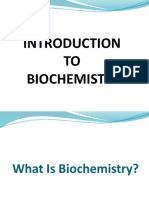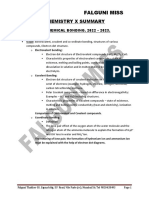Nabeel Shahid (2015-ME-64), Rohail Danish (2015-ME-68)
Nabeel Shahid (2015-ME-64), Rohail Danish (2015-ME-68)
Uploaded by
babaCopyright:
Available Formats
Nabeel Shahid (2015-ME-64), Rohail Danish (2015-ME-68)
Nabeel Shahid (2015-ME-64), Rohail Danish (2015-ME-68)
Uploaded by
babaOriginal Description:
Original Title
Copyright
Available Formats
Share this document
Did you find this document useful?
Is this content inappropriate?
Copyright:
Available Formats
Nabeel Shahid (2015-ME-64), Rohail Danish (2015-ME-68)
Nabeel Shahid (2015-ME-64), Rohail Danish (2015-ME-68)
Uploaded by
babaCopyright:
Available Formats
Performance and Emission Analysis of Diesel Engine on
Biodiesel-Diesel Blends
Nabeel Shahid (2015-ME-64), Rohail Danish (2015-ME-68)
Department of Mechanical Engineering
1. Abstract 2. Objectives 5. Emission Testing
Tremendous inflation in the consumption of fossil fuel as a To find out the biodiesel blend that gives 8-mode emission testing was performed in which the engine
consequence of industrialization and aggrandizement of the best performance compared to diesel emissions are taken at 100%, 75%, 50%, and 10% load at 2250 and
automobiles has led researchers to shift towards sustainable, only and simultaneously show reduced 1400 rpm. The results obtained show that the emissions of CO
renewable and non detrimental fuel alternatives. Biodiesel has emissions and increased efficiency. were reduced by 50% at 2250 and by 34% at 1400 rpm. HC
exhibited a substantial promise in preserving the ecological emissions were also reduced to zero or were halved at 2250 but
balance of earth over the past few years. This study gives were 10% greater for the case of 1400 rpm.
prominence to the experimental investigation of biodiesel derived
from edible feedstock on diesel engine employed in Millat tractors B0 @1400 rpm B5 @1400 rpm B10 @1400 rpm
limited, a well known tractor manufacturing industry in agricultural 20.00 20.00
20.00
18.00
sector of Pakistan. Biodiesel blends incorporated in the 16.00
18.00
16.00
18.00
16.00
experimental study are B0, B5, and B10. The maximum efficiency 14.00 14.00
14.00
percentage/ppm
percentage/ppm
12.00
was found to be 28.84% for B0, 29.03 for B5, and 28.89% for B10. 12.00
percentage/ppm
12.00
CO % CO %
10.00 10.00 CO %
CO2 % CO2 % 10.00
The maximum torque for B0 was found to be 172.97 Nm, 169.96 8.00 HC ppm
NOx ppm
8.00 HC ppm
NOx ppm
8.00
CO2 %
HC ppm
NOx ppm
Nm for B5, and 171.58 Nm for B10. The emission testing showed
6.00 6.00
6.00
4.00 4.00
4.00
that for B5 and B10 the HC and CO emissions were reduced 2.00 2.00
2.00
significantly as compared to B0 but the emissions were more for 0.00
100 75 50
Percentage Load
10
0.00
100 75 50
Percentage Load
10
0.00
100 75 50 10
Percentage Load
B10 as compared to B5. NOx emissions were slightly higher for B5
and B10 as compared to B0. As far as the experimentation that has B0 @2250 rpm B5 @2250 rpm B10 @2250 rpm
20.00 20.00 20.00
been completed B5 is found to perform better than B0 and B10. 18.00 18.00 18.00
16.00 16.00 16.00
14.00 14.00 14.00
3. Methodology
percentage/ppm
percentage/ppm
percentage/ppm
12.00 12.00 12.00
CO CO % CO %
10.00 10.00 10.00
CO2 CO2 % CO2 %
8.00 HC ppm 8.00 HC ppm 8.00 HC ppm
The biodiesel is manufactured in a lab scale automated plant from virgin cooking oil’s reaction with methanol and 6.00
NO x ppm
6.00
NOx ppm
6.00
NOx ppm
Potassium Hydroxide (KOH) as catalyst. This produces methyl esters of the cooking oil. The cooking oil used is a 4.00
2.00
4.00
2.00
4.00
2.00
mixture of soy bean oil and canola oil. Biodiesel is then separated from the byproduct glycerol and other 0.00
100 75 50 10
0.00
100 75 50 10
0.00
100 75 50 10
unreacted substances and cleaned. It is then mixed with diesel to form blends. The engine is run for five Percentage Load Percentage Load Percentage Load
performance tests on diesel and then biodiesel-diesel blends B5, and B10. 8-Mode emission test cycle is a non-
road steady cycle (NSRC) which will be applied to check the concentration of exhaust gases after every
performance test as described above. 6. Fuel Testing
The fuel tests conducted for diesel and biodiesel comprise of
calculation of calorific value from bomb calorimeter, flash, pour
BioDiesel Distillation Curve
350 and cloud point tests and ASTM D4737 four variable method for
300
calculating cetane index. The calorific values for diesel and
Recovery Temperature
250
4. Performance Results 200
150
100
biodiesel came out to be 45.9 MJ/kg and 50.5 MJ/kg, respectively.
CCI value attained from the distillation of fuels and the method
The curves obtained are show that there is little 50
ASTM provided have values of 61.4 for biodiesel and 40.9 for
change in power and torque at high rpm and low 0
0 10 20 30 40 50 60
Percentage Recovery
70 80 90 100
diesel.
load. At 1800 rpm and below the difference in BioDiesel
the torque becomes clearer. However the
change in power as a percentage of total power Acknowledgements
is very low. The efficiency curve obtained is We are highly grateful to research and development department
rough but show a general trend that efficiency is of Millat Tractors Limited for carrying out complete emission and
highest for B5, then B10 and then B0. The performance tests regarding this experimental analysis. The
maximum efficiency point is obtained at 1600 cognizance of our supervisor Dr. Ali Hussain Kazim and financial
rpm. support from UET Mechanical Department assisted us to
complete this study. We are also thankful to Punjab University
Fuel Testing Laboratory for conducting fuel tests.
References Future Prospects
[1] P. Tamilselvan, N. Nallusamy, and S. Rajkumar, “A comprehensive review on performance,
combustion and emission characteristics of biodiesel fuelled diesel engines,” Renew. Sustain. The steps that can be employed in the future regarding biodiesel
Energy Rev., vol. 79, no. May, pp. 1134–1159, 2017. production is the use of vast desert areas of Pakistan for
[2] A. K. Agarwal, J. G. Gupta, and A. Dhar, “Potential and challenges for large-scale application of biodiesel in plantation of Jatropha so that barrier of limited reserves of edible
automotive sector,” Prog. Energy Combust. Sci., vol. 61, pp. 113–149, 2017. oils can be crossed. Feedstocks obtained from algae and animal
fats should also be considered as sideways method for extending
its production to market scale.
You might also like
- Synthetic AmphetamineDocument57 pagesSynthetic Amphetaminelumik123475% (4)
- Is 335Document16 pagesIs 335EME HPCNo ratings yet
- Asia Securities-FIC Update- 20 November 2024Document1 pageAsia Securities-FIC Update- 20 November 2024randikayasiru1995No ratings yet
- POWER Layout2 PDFDocument1 pagePOWER Layout2 PDFCes Tala GelogoNo ratings yet
- pumabici-Model.pdfDocument1 pagepumabici-Model.pdfcarrillo.martinez.ian.biNo ratings yet
- Medidas Lote 10 MZ 115 2 Fracc MexDocument1 pageMedidas Lote 10 MZ 115 2 Fracc MexCuervos NegrosNo ratings yet
- Medidas Lote 10 MZ 115 Fracc MexDocument1 pageMedidas Lote 10 MZ 115 Fracc MexCuervos NegrosNo ratings yet
- Lote MontadoDocument1 pageLote MontadoHECTORKANo ratings yet
- Archivo Ejecutivo 01.02 ModelDocument1 pageArchivo Ejecutivo 01.02 Modelmonse pradoNo ratings yet
- Benchvise Draft PDFDocument3 pagesBenchvise Draft PDFUTSAV SHARMA 17BME0600No ratings yet
- Denah - Gedung Kuliah Terpadu POLINESDocument8 pagesDenah - Gedung Kuliah Terpadu POLINESuptbahasa2002No ratings yet
- Lapangan Olahraga IndoorDocument1 pageLapangan Olahraga Indoorzuhairi arizonaNo ratings yet
- UPDATED Fan Laws Part 2Document37 pagesUPDATED Fan Laws Part 2sahar.ahmed4200No ratings yet
- Lotizacion CarapongoDocument1 pageLotizacion CarapongoGEOMAP PROJECTNo ratings yet
- Potato 2Document11 pagesPotato 2Soumya ChakrabortyNo ratings yet
- RR - PP Junio 2024Document1 pageRR - PP Junio 2024Romer PimentelNo ratings yet
- KINDER-Layout1Document1 pageKINDER-Layout1Citlalli OlivaresNo ratings yet
- A A B B A B: Primer Nivel Semi Sotano Segundo NivelDocument1 pageA A B B A B: Primer Nivel Semi Sotano Segundo NivelJesus JaraNo ratings yet
- Hops 2Document1 pageHops 2Alan Tenorio MartinezNo ratings yet
- Annexe 3Document1 pageAnnexe 3Ayoub AJDIDINo ratings yet
- Plano Mirador de TarapotoDocument1 pagePlano Mirador de TarapotoDiego ENo ratings yet
- Plano Mirador de TarapotoDocument1 pagePlano Mirador de TarapotoDiego ENo ratings yet
- Project Finance Modelling and The Corona VirusDocument47 pagesProject Finance Modelling and The Corona VirusK RameshNo ratings yet
- PlanoDocument1 pagePlanoDIANA PRADONo ratings yet
- abutmen-1Document1 pageabutmen-1fajarNo ratings yet
- Plantas Edificio ADocument1 pagePlantas Edificio AGino Neira GrandiNo ratings yet
- Indicadores Perforadoras 2020 GMIN: FEBRERO 2020Document33 pagesIndicadores Perforadoras 2020 GMIN: FEBRERO 2020laura trejoNo ratings yet
- Distribution PlanDocument1 pageDistribution PlanJunior BagaNo ratings yet
- Julio Cesar Castillo Guzman.Document1 pageJulio Cesar Castillo Guzman.Julio Cesar Castillo GuzmanNo ratings yet
- Projeto Residencia Rio Bravo ArquitetônicoDocument1 pageProjeto Residencia Rio Bravo Arquitetônicojeferson timothioNo ratings yet
- Loft Plan Drainage, Waste, Vent Layout: To Nearest Public Waste Water Line To Nearest Public Waste Water LineDocument1 pageLoft Plan Drainage, Waste, Vent Layout: To Nearest Public Waste Water Line To Nearest Public Waste Water LinemcajucomNo ratings yet
- Vue en Plan RDC 1er ProDocument1 pageVue en Plan RDC 1er Pro21074No ratings yet
- Penyedia Jasa Pengawas Lapangan Pekerjaan: Shop Drawing Cv. Batang GadisDocument1 pagePenyedia Jasa Pengawas Lapangan Pekerjaan: Shop Drawing Cv. Batang GadisRahul Anggaranta SNo ratings yet
- Dep Duplex RITA MAMANI 1 PDFDocument1 pageDep Duplex RITA MAMANI 1 PDFGustavo SuaznabarNo ratings yet
- "Denah": Skala 1: 100Document4 pages"Denah": Skala 1: 100Idha HandayaniNo ratings yet
- Penyedia Jasa Pengawas Lapangan Pekerjaan: Shop Drawing Cv. Batang GadisDocument1 pagePenyedia Jasa Pengawas Lapangan Pekerjaan: Shop Drawing Cv. Batang GadisRahul Anggaranta SNo ratings yet
- 21TDRPCR400 Drawings - Jarvis Bay PP Campground 2Document29 pages21TDRPCR400 Drawings - Jarvis Bay PP Campground 2mansoj777No ratings yet
- Page 4 - Power & Co LayoutDocument1 pagePage 4 - Power & Co LayoutElynor Acio MercadoNo ratings yet
- Poster Ex2Document1 pagePoster Ex2jim0410168No ratings yet
- Julio Cesar Castillo Guzman-Model1Document1 pageJulio Cesar Castillo Guzman-Model1Julio Cesar Castillo GuzmanNo ratings yet
- Projeto Residencia Rio Bravo ArquitetônicoDocument1 pageProjeto Residencia Rio Bravo Arquitetônicojeferson timothioNo ratings yet
- Plano Catastral LlataDocument1 pagePlano Catastral LlataLee Rozhariio RodríguezNo ratings yet
- Single Well Pad FH-: FH-5A (Z) - B.M-2Document1 pageSingle Well Pad FH-: FH-5A (Z) - B.M-2m.y.ahmmed92No ratings yet
- Clean Water Supply Layout: 1/2'' Dia. PPR Pipe 1/2'' Dia. PPR PipeDocument1 pageClean Water Supply Layout: 1/2'' Dia. PPR Pipe 1/2'' Dia. PPR PipemcajucomNo ratings yet
- Study On The Production of AACDocument8 pagesStudy On The Production of AACVignesh AyyathuraiNo ratings yet
- MOKKO Factory Palembang Square: ProjectDocument1 pageMOKKO Factory Palembang Square: ProjectvhietsweetNo ratings yet
- Keterangan Notasi: A B CD E A C E A' D B C CDocument1 pageKeterangan Notasi: A B CD E A C E A' D B C CwistaraarchitectstudioNo ratings yet
- Plano - Cond - Costa Azul-64Document1 pagePlano - Cond - Costa Azul-64Gera AlarcónNo ratings yet
- Plano - Cond - Costa Azul-1 PDFDocument1 pagePlano - Cond - Costa Azul-1 PDFEfrain Cabrera ValdiviaNo ratings yet
- Asia Securities-FIC Update- 11 December 2024Document1 pageAsia Securities-FIC Update- 11 December 2024randikayasiru1995No ratings yet
- SD - Tie beam Levels A1Document2 pagesSD - Tie beam Levels A1qc.liwanNo ratings yet
- Ground Floor Plan Second Floor Plan: As Shown Jaecon D. JumagdaoDocument1 pageGround Floor Plan Second Floor Plan: As Shown Jaecon D. Jumagdaomatthew waniwanNo ratings yet
- Fundamentals of Centrifugal Pumps PDFDocument7 pagesFundamentals of Centrifugal Pumps PDFÁlvaro Martínez FernándezNo ratings yet
- Placement StatDocument3 pagesPlacement Statprepbooster100No ratings yet
- Sunken Porch Sunken Solarium: Dressing RoomDocument1 pageSunken Porch Sunken Solarium: Dressing RoomTrishia EndayaNo ratings yet
- Construction and Building Materials: Ali A. Mohammed, Allan C. Manalo, Ginghis B. Maranan, Yan Zhuge, P.V. VijayDocument11 pagesConstruction and Building Materials: Ali A. Mohammed, Allan C. Manalo, Ginghis B. Maranan, Yan Zhuge, P.V. VijayAliNo ratings yet
- Elevation Views of Prop - Pumphouse With FenceDocument1 pageElevation Views of Prop - Pumphouse With FenceRODEL YUNTINGNo ratings yet
- VIVIENDA LAREDO-Model-ModelDocument1 pageVIVIENDA LAREDO-Model-ModelLeslie sophie Venegas castroNo ratings yet
- Maulidiah_PBG_Pemb. Lap TerpaduDocument5 pagesMaulidiah_PBG_Pemb. Lap TerpaduBarnadha Brian GarindhiNo ratings yet
- Roof Deck Plan: Mr. & Mrs. Clemente & Divina AleaDocument1 pageRoof Deck Plan: Mr. & Mrs. Clemente & Divina AleaCyril AleaNo ratings yet
- PPC Series Technical DataDocument4 pagesPPC Series Technical DataJaldhij PatelNo ratings yet
- ESAB ExtractPage29-30cDocument9 pagesESAB ExtractPage29-30cDries VandezandeNo ratings yet
- Dupont Refrigerants: R-22 ReplacementsDocument4 pagesDupont Refrigerants: R-22 ReplacementsEzsilvasilva SilvaNo ratings yet
- PH 5218 Quantum Mechanics, Atomic and Molecular Physics - UG - 1st Sem-Dec-2022Document2 pagesPH 5218 Quantum Mechanics, Atomic and Molecular Physics - UG - 1st Sem-Dec-2022Soumyadeep DasNo ratings yet
- Mowicoll PS 7560 ENDocument3 pagesMowicoll PS 7560 ENRuben ZapataNo ratings yet
- Berihun ApparentDocument33 pagesBerihun ApparentbernabasNo ratings yet
- Chemical Process MCQs PDFDocument72 pagesChemical Process MCQs PDFAman Kumar TiwariNo ratings yet
- GEA Evaporation-Technology Brochure EN tcm11-16319 PDFDocument24 pagesGEA Evaporation-Technology Brochure EN tcm11-16319 PDFItsartNo ratings yet
- Introduction To BiochemistryDocument97 pagesIntroduction To BiochemistryTsiamo AristideNo ratings yet
- OJT Case StudyDocument17 pagesOJT Case StudyClaudine Cabico ValdezNo ratings yet
- Bachelor of Science in Project and Facility Management With Honours (BPFM)Document12 pagesBachelor of Science in Project and Facility Management With Honours (BPFM)Has LizaNo ratings yet
- Uns N06625Document1 pageUns N06625robertNo ratings yet
- Power Plant Engineering Notes UNIT 1Document33 pagesPower Plant Engineering Notes UNIT 1aakashNo ratings yet
- Article Isoenzymes Clinical Diagnosis: SpecialDocument10 pagesArticle Isoenzymes Clinical Diagnosis: Specialanmol bandekarNo ratings yet
- MWP11A - Learning Unit 8 PlasticsDocument17 pagesMWP11A - Learning Unit 8 PlasticsThapelo MokoenaNo ratings yet
- Waste Water TreatmentDocument28 pagesWaste Water Treatmentsaurabhjoshi26108285% (40)
- New Microsoft Word DocumentDocument3 pagesNew Microsoft Word DocumentNripesh PokhrelNo ratings yet
- Notes For Nutrition Class 9Document2 pagesNotes For Nutrition Class 9Priyansh DwivediNo ratings yet
- 02 CHEM X ICSE SUMMARY Chemical BondingDocument9 pages02 CHEM X ICSE SUMMARY Chemical BondingNatasha DalalNo ratings yet
- C57 637-2015 PDFDocument38 pagesC57 637-2015 PDFnamsaigon316No ratings yet
- Analysis of Modular Dynamic Formation Test Results From The Mount Elbert-01 Stratigraphic Test Well, Milne Point Unit, North Slope AlaskaDocument12 pagesAnalysis of Modular Dynamic Formation Test Results From The Mount Elbert-01 Stratigraphic Test Well, Milne Point Unit, North Slope Alaskamuneeb tahirNo ratings yet
- Review Questions Physical Science NewwwDocument1 pageReview Questions Physical Science NewwwKamila SofiaNo ratings yet
- Strength and Behaviour of Carbon Nanotube Reinforced CementDocument41 pagesStrength and Behaviour of Carbon Nanotube Reinforced CementSanjithRNairNo ratings yet
- Denatured Alcohol, BI GHS 2012Document15 pagesDenatured Alcohol, BI GHS 2012Nur Isma NazariahNo ratings yet
- ColaTerge BCCDocument2 pagesColaTerge BCCmndmattNo ratings yet
- Unit-3 Electrochemistry and ApplicationsDocument19 pagesUnit-3 Electrochemistry and ApplicationsjdevisantoshkumarNo ratings yet
- Pultrusion of Glass Fibre Reinforced Maleated-PP Modified PP Matrix CompositesDocument10 pagesPultrusion of Glass Fibre Reinforced Maleated-PP Modified PP Matrix CompositesОлег ШибекоNo ratings yet
- Metco 15E MSDSDocument13 pagesMetco 15E MSDSSerkan ÖzcanNo ratings yet
- Science Stage 8 Sample Paper 2 - tcm143-595705Document18 pagesScience Stage 8 Sample Paper 2 - tcm143-595705Sandy Belle75% (4)

























































































